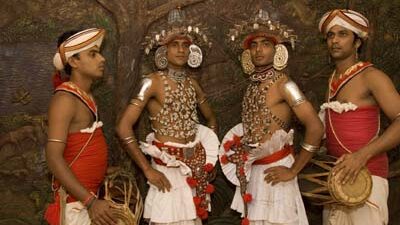By The Frontpage Journal
In a brightly lit rehearsal hall in Kandy, a young dancer spins across the polished floor, his movements precise and fluid, each gesture echoing centuries of tradition. Outside, his troupe’s latest performance video is going viral on Instagram. With drums pounding in the background and hashtags guiding global audiences to their feed, this is the new face of Kandyan dance—rooted in ritual, refined through discipline, and now reimagined for a digital world.
Kandyan dance, or Udarata Natum, is among Sri Lanka’s most iconic cultural expressions. Once performed exclusively in temples as offerings to the gods, it is a spiritual and physical language passed down through generations. The dances are intricate, with stylized movements, elaborate costumes, and percussive rhythms from traditional drums. Historically performed during religious processions like the Esala Perahera, Kandyan dance was a form of devotion, art, and storytelling, all choreographed into one.
Today, this revered tradition faces the challenge of cultural continuity in a fast-changing world. With younger generations drawn to urban life, global media, and modern entertainment, many feared that classical dance forms would lose relevance. Yet a quiet transformation is underway, led by dancers who are as comfortable with a smartphone as they are in ceremonial garb.
One such example is the Rangadhari Dance Ensemble, a youth-led troupe based in Kandy. Led by 28-year-old choreographer Nipun Jayatunga, the group has made it their mission to carry forward the grace and discipline of Kandyan dance while using digital platforms to broaden their reach. Their YouTube channel features both traditional performances and behind-the-scenes footage of rehearsals, costume preparation, and training sessions. On Instagram, clips of gravity-defying leaps and slow-motion spins are paired with traditional chants or remixed beats, attracting followers from across the world.
For Nipun, the digital shift is not a departure from heritage but an expansion of it. He sees social media as a stage without borders, allowing an ancient Sri Lankan art form to travel further than ever before. His troupe’s posts often come with captions explaining the origin and meaning of certain dance movements, creating a space for cultural education as well as appreciation.
The shift is not without its critics. Purists worry that condensing centuries of sacred performance into 30-second clips could dilute the art form’s depth and ritual significance. Others argue that the essence of Kandyan dance lies in the live energy between the performer and the audience, something that no screen can replicate. But dancers like Nipun counter that the goal is not to replace tradition but to sustain it. By engaging new audiences and inviting dialogue, they are ensuring that Kandyan dance remains visible, relevant, and vibrant.
The digital transition has also created opportunities for collaboration and innovation. Some troupes have begun fusing Kandyan movements with contemporary dance or theatre, performing in festivals that mix traditional and modern genres. Others have participated in global cultural exchanges, where Sri Lankan dance is showcased alongside other classical forms from Asia and Africa. These cross-cultural spaces have helped redefine Kandyan dance not just as a national symbol but as a dynamic art form capable of evolving while remaining true to its roots.
There is also a growing interest among foreign learners. Through online classes and video tutorials, international students are studying the foundations of Kandyan dance from afar. For them, it is both a form of cultural immersion and a physical discipline. Some even travel to Sri Lanka to experience the training firsthand, joining workshops held in temple courtyards and rural dance schools.
In all these efforts, the underlying message is clear. The survival of a cultural tradition does not always lie in preservation alone but in reinvention. When performed on a festival stage, Kandyan dance evokes divine protection and historical pride. When shared on TikTok or YouTube, it invites curiosity and admiration from across the globe. Both are valid. Both are necessary.
The story of Kandyan dancers in the digital age is one of resilience and imagination. It is a story where grace meets grit, and where ancient rhythms find their echo in the pulse of modern life. Through stage and screen, costume and code, these dancers are proving that tradition can still move—powerfully, purposefully, and without missing a beat.




